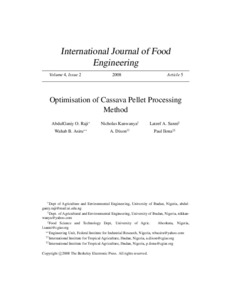| dc.contributor.author | Raji, A.O. |
| dc.contributor.author | Kanwanya, N. |
| dc.contributor.author | Sanni, L.A. |
| dc.contributor.author | Asiru, W.B. |
| dc.contributor.author | Dixon, A. |
| dc.contributor.author | Ilona, P. |
| dc.date.accessioned | 2019-12-04T11:15:01Z |
| dc.date.available | 2019-12-04T11:15:01Z |
| dc.date.issued | 2008 |
| dc.identifier.citation | Raji, A.O., Kanwanya, N., Sanni, L.A., Asiru, W.B., Dixon, A. & Ilona, P. (2008). Optimisation of Cassava Pellet Processing Method. International Journal of Food Engineering, 4(2), 1-15. |
| dc.identifier.issn | 1556-3758 |
| dc.identifier.uri | https://hdl.handle.net/20.500.12478/2901 |
| dc.description | Open Access Journal; Published online: 10 March 2008 |
| dc.description.abstract | Processing cassava onto pellets, an internationally acceptable and commercially rewarding cassava product minimizes quantitative and qualitative losses. Pellet samples were produced through the conventional chipping, drying, milling then pelleting with and without steaming (CDMP-S and CDMP) and modified process of grating, dewatering then pelleting and steaming (GDWP-S). Investigations for storageability, durability, uniformity in dimension and nutritional qualities resulted in pellets with moisture content of 9%, uniformly light brown in colour, free from objectionable odour with no sign of deterioration after 90 days of storage. The durability index and fine formations are 99.8% and 0.2%, 98.8% and 1.2%, 99.4% and 0.6% for CDMP-S, CDMP and GDWP-S respectively. The average lengths of 2.81, 2.23 and 2.74 cm and diameters 0.76, 0.73 and 0.67 cm respectively fall within the standard. The carbohydrate contents are 82.9%, 83.4% and 84.5% and cyanogenic glycosides contents of 14.18mg/100g, 14.32mg/100g and 10.13mg/100g respectively. The pellets produced from the modified process GDWP-S in addition to satisfying the standard colour code also conforms favourably well in terms of strength, durability and nutritional quality with the conventional CDMP-S and are better than the cold pellets from the conventional process CDMP. These are in addition to the reduction of about eight hours of chip drying operation in the modified process. This reduction in time and energy with associated quality products show that the modified process is a promising approach in the production of pellets acceptable in the export market. |
| dc.language.iso | en |
| dc.subject | Cassava |
| dc.subject | Pellet |
| dc.subject | Optimisation |
| dc.subject | Processing |
| dc.subject | Grating |
| dc.subject | Nutritional Quality |
| dc.title | Optimisation of cassava pellet processing method |
| dc.type | Journal Article |
| dc.description.version | Peer Review |
| cg.contributor.affiliation | University of Ibadan |
| cg.contributor.affiliation | Federal University of Agriculture, Nigeria |
| cg.contributor.affiliation | Federal Institute of Industrial Research, Nigeria |
| cg.contributor.affiliation | International Institute of Tropical Agriculture |
| cg.coverage.region | Africa |
| cg.coverage.region | West Africa |
| cg.coverage.country | Nigeria |
| cg.authorship.types | CGIAR and developing country institute |
| cg.iitasubject | Livelihoods |
| cg.iitasubject | Policies And Institutions |
| cg.iitasubject | Markets |
| cg.iitasubject | Agribusiness |
| cg.iitasubject | Crop Systems |
| cg.iitasubject | Food Security |
| cg.iitasubject | Farm Management |
| cg.iitasubject | Handling, Transport, Storage And Protection Of Agricultural Products |
| cg.iitasubject | Nutrition |
| cg.iitasubject | Domestic Trade |
| cg.accessibilitystatus | Open Access |
| local.dspaceid | 94002 |
| cg.identifier.doi | http://dx.doi.org/10.2202/1556-3758.1234. |

